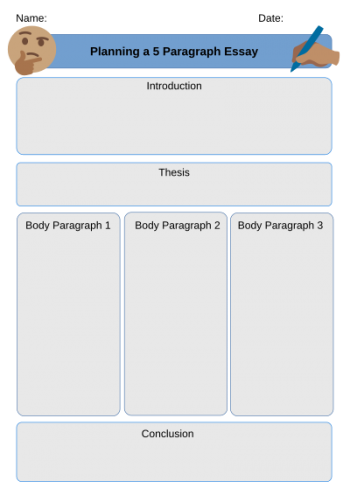Remixing a graphic organiser
Background
The graphic organiser Planning a 5 paragraph essay, shown on the right, was developed as a practical example for this course. (Download the PDF version (26KB)). The aim was to illustrate the use of vector graphics to generate an editable teaching resource. We also generated this mini-case study to highlight practical challenges and how they were resolved.
The resource was produced using LibreOffice Draw, a graphics software package that can edit vector graphics.
Process
Searching online for graphic organisers, we found this example of a 5 Paragraph Essay Outline published by Freeology.com. Distributed under a Creative Commons Attribution-NonCommercial-ShareAlike 3.0 United States licence, this resource is an OER and was selected as a starting point for this project. The plan was to:
- introduce colour
- add two SVG graphics to the resource
- re-distribute it as an editable resource for school teachers under an open licence
Searching the Wikimedia Commons for SVG icons, we found two emojis:
Challenges
- The original resource, published by Freeology.com, was in PDF format, which is not easy to edit. In open education, we promote the distribution of OERs using open and editable file formats, so that teachers can easily edit these resources
- The UNESCO Recommendation on OER promotes inclusive access, so for the Pacific region we wanted to adapt the colour of the yellow Thinking emoji to reflect a medium skin tone. (The Writing Hand emoji was already published as a medium skin tone.)
Solutions implemented
- Using LibreOffice Draw, we generated 7 rounded corner rectangles to re-produce the layout of the original graphic organiser, and added the relevant text headings and coloured backgrounds
- We added the two SVG emoji graphics to the document. As SVG files, they could easily be re-sized without pixelation. Also, being SVG files, the yellow Thinking emoji colours could easily be adapted
- After adding the yellow SVG emoji, using LibreOffice Draw, we clicked on the image. Then, via the Menu option: Modify --> Break, we could separate the image components to recolour these individually
- The document was saved in two editable file formats: First in .ODG (LibreOffice Draw's native file format), then exported as an .SVG file, before also exporting it as a PDF
- The final resource was licensed for re-use under a Attribution-ShareAlike 3.0 IGO licence
The advantages enabled by OER
- By spending a little extra effort converting an openly licensed PDF resource into editable file formats, we have reduced the effort needed for future adaptations. Colours, graphics and wording can now be easily changed in a few minutes
- The use of editable SVGs means that users can change the colour and/or size of an image in the future
Additional notes about licensing
To avoid confusion, here are some additional notes on the licensing of this unique situation:
- A few notes on the licensing of the work under a Attribution-ShareAlike 3.0 IGO licence
- The original PDF resource, published by Freeology.com, was licensed under Creative Commons Attribution-NonCommercial-ShareAlike 3.0 United States (CC BY-NC-SA). Normally, a CC BY-NC-SA resource cannot be re-mixed and released under the less strict CC BY-SA licence, because this is not the same licence. However, in this example, we did not derive the work from a copy of the original. A new work was generated, and as there is no copyright on ideas, and the few words re-used would not meet the thresholds for a creative work, we could legitimately apply a CC-BY-SA licence
- The Apache License, Version 2.0 is a permissive licence that does not have a copy-left provision requiring derivatives to use the same licence. This means we could apply an alternate licence
- The copyright of this work does not belong to the author, because it was commissioned by the Commonwealth of Learning (COL) for this course development project, and they are the copyright holder. COL's default licensing policy is to apply the CC-BY-SA licence. You will notice that a special version is used, specifically the Attribution-ShareAlike 3.0 IGO licence. This is a special series of CC licences developed specifically for Inter-Governmental Organisations (IGOs) to overcome the previous version challenges requiring disputes to be handled through national courts. IGOs work under the jurisdictions of the international court system, not at the national level
